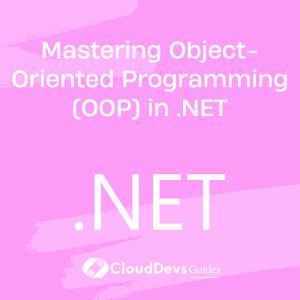Mastering Object-Oriented Programming (OOP) in .NET
Table of Contents
Object-Oriented Programming (OOP) is a cornerstone of modern software development, allowing developers to build flexible, reusable, and scalable applications. The .NET framework, with its rich set of tools and libraries, provides robust support for OOP principles. This article explores how to master OOP in .NET, offering practical examples and best practices to help you leverage its full potential.

Understanding Object-Oriented Programming
Object-Oriented Programming is a paradigm that organizes software design around objects, which represent real-world entities. These objects encapsulate data and behavior, promoting code reuse and modularity. Key OOP concepts include classes, objects, inheritance, polymorphism, encapsulation, and abstraction.
Leveraging OOP in .NET
.NET is a powerful framework that supports OOP principles through languages like C# and VB.NET. Let’s explore key aspects of OOP in .NET with practical examples.
1. Defining Classes and Objects
Classes are blueprints for objects, defining their properties and behaviors. In .NET, you can create classes to model real-world entities and instantiate objects from these classes.
Example: Creating a Simple Class and Object
```csharp
public class Car
{
public string Make { get; set; }
public string Model { get; set; }
public int Year { get; set; }
public void StartEngine()
{
Console.WriteLine("Engine started.");
}
}
class Program
{
static void Main()
{
Car myCar = new Car { Make = "Toyota", Model = "Camry", Year = 2020 };
myCar.StartEngine();
Console.WriteLine($"{myCar.Make} {myCar.Model} ({myCar.Year})");
}
}
```
2. Implementing Inheritance
Inheritance allows a class to inherit properties and methods from another class, promoting code reuse and hierarchy in OOP design.
Example: Implementing Inheritance
```csharp
public class Vehicle
{
public string Make { get; set; }
public string Model { get; set; }
public void Drive()
{
Console.WriteLine("Driving...");
}
}
public class Car : Vehicle
{
public int Year { get; set; }
}
class Program
{
static void Main()
{
Car myCar = new Car { Make = "Honda", Model = "Accord", Year = 2019 };
myCar.Drive();
Console.WriteLine($"{myCar.Make} {myCar.Model} ({myCar.Year})");
}
}
```
3. Exploring Polymorphism
Polymorphism enables objects to be treated as instances of their parent class while retaining their own behavior, making it easier to write generic and scalable code.
Example: Polymorphism in Action
```csharp
public class Vehicle
{
public virtual void Honk()
{
Console.WriteLine("Vehicle horn!");
}
}
public class Car : Vehicle
{
public override void Honk()
{
Console.WriteLine("Car horn!");
}
}
public class Truck : Vehicle
{
public override void Honk()
{
Console.WriteLine("Truck horn!");
}
}
class Program
{
static void Main()
{
Vehicle myCar = new Car();
Vehicle myTruck = new Truck();
myCar.Honk();
myTruck.Honk();
}
}
```
4. Encapsulation and Abstraction
Encapsulation hides the internal state of objects, while abstraction simplifies complex systems by exposing only the necessary details. .NET offers various access modifiers to enforce encapsulation.
Example: Encapsulation with Properties
```csharp
public class Account
{
private decimal balance;
public decimal Balance
{
get { return balance; }
set
{
if (value >= 0)
balance = value;
}
}
public void Deposit(decimal amount)
{
if (amount > 0)
Balance += amount;
}
}
class Program
{
static void Main()
{
Account account = new Account();
account.Deposit(100);
Console.WriteLine($"Balance: {account.Balance}");
}
}
```
Applying OOP Best Practices in .NET
Mastering OOP requires more than understanding principles; it involves applying best practices to create efficient, maintainable, and scalable code. Here are a few tips:
- SOLID Principles: Follow the SOLID principles for better OOP design.
- Design Patterns: Implement common design patterns like Singleton, Factory, and Observer.
- Encapsulation: Always encapsulate data and provide controlled access through methods or properties.
- Use Interfaces: Leverage interfaces for loose coupling and easier testing.
- Keep It Simple: Avoid overcomplicating your class designs; simplicity is key to maintainability.
Conclusion
Object-Oriented Programming is a powerful paradigm that, when mastered, can significantly enhance your ability to develop scalable, maintainable, and efficient software. The .NET framework provides excellent support for OOP, making it an ideal platform for building modern applications. By leveraging OOP principles and best practices in .NET, you can create software that is robust, flexible, and easy to maintain.



